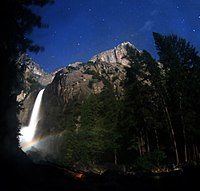Moonbow
From Wikipedia, the free encyclopedia
A moonbow (also known as a lunar rainbow, lunar bow or white rainbow) is a rainbow produced by the moon rather than the sun. Moonbows are relatively faint, due to the smaller amount of light from the Moon. They are always in the opposite part of the sky from the moon.
It is difficult for the human eye to discern colours in a moonbow because the light is usually too faint to excite the cone colour receptors in human eyes. As a result, they often appear to be white.[1] However, the colours in a moonbow do appear in long exposure photographs.
A coloured circle around the moon is not a moonbow—it is usually a 22° halo produced by refraction through hexagonal ice crystals in cirrus cloud. Coloured rings close to the moon are a corona, a diffraction phenomenon produced by very small water droplets or ice crystals in clouds.
Moonbows are most easily viewed when the moon is near to full (when it is brightest). For other than those produced by waterfalls, the moon must be low in the sky (less than 42 degrees and preferably lower) and the sky must be dark. And of course there must be rain falling opposite the moon. This combination of requirements makes moonbows much more rare than rainbows produced by the sun.
There have been rare instances of rainbows appearing around the moon itself in foggy weather.
Contents |
[edit] Famous natural moonbow locations

Few places in the world frequently feature this phenomenon. Cumberland Falls[2], near Williamsburg, Kentucky, U.S.A.; Waimea, Hawaii, U.S.A.; and Victoria Falls on the border between Zambia and Zimbabwe are widely known for moonbow occurrence. The only site of the moonbow that has not been destroyed by natural disaster is at the Cumberland Falls National Park in Corbin, Kentucky. It is known now as one of the natural wonders of the world.
[edit] References
- ^ Walklet, Keith S. (2006). "Lunar Rainbows - When to View and How to Photograph a "Moonbow"". The Ansel Adams Gallery. http://www.anseladams.com/content/newsletter/lunar_rainbow.html. Retrieved on 2007-07-09.
- ^ Bailey, Bill (1995). "Cumberland Falls State Resort Park". Kentucky State Parks. Saginaw, Michigan: Glovebox Guidebooks of America. ISBN 1881139131.


